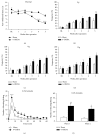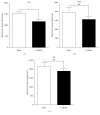Restoring Spinal Noradrenergic Inhibitory Tone Attenuates Pain Hypersensitivity in a Rat Model of Parkinson's Disease
- PMID: 27747105
- PMCID: PMC5056271
- DOI: 10.1155/2016/6383240
Restoring Spinal Noradrenergic Inhibitory Tone Attenuates Pain Hypersensitivity in a Rat Model of Parkinson's Disease
Abstract
In the present study, we investigated whether restoring descending noradrenergic inhibitory tone can attenuate pain in a PD rat model, which was established by stereotaxic infusion of 6-hydroxydopamine (6-OHDA) into the bilateral striatum (CPu). PD rats developed thermal and mechanical hypersensitivity at the 4th week after surgery. HPLC analysis showed that NE content, but not dopamine or 5-HT, significantly decreased in lumbar spinal cord in PD rats. Additional noradrenergic depletion by injection of N-(2-chloroethyl)-N-ethyl-2-bromobenzylamine (DSP-4) aggravated pain hypersensitivity in PD rats. At the 5th week after injection of 6-OHDA, systemic treatment with pharmacological norepinephrine (NE) precursor droxidopa (L-DOPS) or α2 adrenoceptor agonist clonidine significantly attenuated thermal and mechanical pain hypersensitivity in PD rats. Furthermore, application of norepinephrine (NE) and 5-hydroxytryptamine (5-HT) reuptake inhibitors duloxetine, but not 5-HT selective reuptake inhibitors sertraline, significantly inhibited thermal and mechanical pain hypersensitivity in PD rats. Systemic administration of Madopar (L-DOPA) or the D2/D3 agonist pramipexole slightly inhibited the thermal, but not mechanical, hypersensitivity in PD rats. Thus, our study revealed that impairment of descending noradrenergic system may play a key role in PD-associated pain and restoring spinal noradrenergic inhibitory tone may serve as a novel strategy to manage PD-associated pain.
Conflict of interest statement
The authors state no conflict of interests.
Figures








Similar articles
-
L-DOPA-induced dyskinesia in a rat model of Parkinson's disease is associated with the fluctuational release of norepinephrine in the sensorimotor striatum.J Neurosci Res. 2014 Dec;92(12):1733-45. doi: 10.1002/jnr.23439. Epub 2014 Jun 26. J Neurosci Res. 2014. PMID: 24975553
-
Regulation of nociception threshold by norepinephrine through adrenergic α2 receptor in rat models of Parkinson's disease.CNS Neurosci Ther. 2024 Mar;30(3):e14446. doi: 10.1111/cns.14446. Epub 2023 Sep 18. CNS Neurosci Ther. 2024. PMID: 37721421 Free PMC article.
-
Additional noradrenergic depletion aggravates forelimb akinesia and abnormal subthalamic nucleus activity in a rat model of Parkinson's disease.Life Sci. 2014 Dec 5;119(1-2):18-27. doi: 10.1016/j.lfs.2014.10.007. Epub 2014 Nov 1. Life Sci. 2014. PMID: 25445222
-
Behavioral and neurochemical effects of noradrenergic depletions with N-(2-chloroethyl)-N-ethyl-2-bromobenzylamine in 6-hydroxydopamine-induced rat model of Parkinson's disease.Behav Brain Res. 2004 May 5;151(1-2):191-9. doi: 10.1016/j.bbr.2003.08.016. Behav Brain Res. 2004. PMID: 15084435
-
Strategies to Treat Chronic Pain and Strengthen Impaired Descending Noradrenergic Inhibitory System.Int J Mol Sci. 2019 Feb 14;20(4):822. doi: 10.3390/ijms20040822. Int J Mol Sci. 2019. PMID: 30769838 Free PMC article. Review.
Cited by
-
Inhibition of Spinal 5-HT3 Receptor and Spinal Dorsal Horn Neuronal Excitability Alleviates Hyperalgesia in a Rat Model of Parkinson's Disease.Mol Neurobiol. 2022 Dec;59(12):7253-7264. doi: 10.1007/s12035-022-03034-8. Epub 2022 Sep 27. Mol Neurobiol. 2022. PMID: 36168076
-
Preclinical reserpine models recapitulating motor and non-motor features of Parkinson's disease: Roles of epigenetic upregulation of alpha-synuclein and autophagy impairment.Front Pharmacol. 2022 Oct 12;13:944376. doi: 10.3389/fphar.2022.944376. eCollection 2022. Front Pharmacol. 2022. PMID: 36313295 Free PMC article.
-
Altered parabrachial nucleus nociceptive processing may underlie central pain in Parkinson's disease.NPJ Parkinsons Dis. 2023 May 26;9(1):78. doi: 10.1038/s41531-023-00516-x. NPJ Parkinsons Dis. 2023. PMID: 37236965 Free PMC article.
-
The FDA-approved compound, pramipexole and the clinical-stage investigational drug, dexpramipexole, reverse chronic allodynia from sciatic nerve damage in mice, and alter IL-1β and IL-10 expression from immune cell culture.Neurosci Lett. 2023 Sep 25;814:137419. doi: 10.1016/j.neulet.2023.137419. Epub 2023 Aug 7. Neurosci Lett. 2023. PMID: 37558176 Free PMC article.
-
Effects of tapentadol on pain, motor symptoms and cognitive functions in Parkinson's disease.J Pain Res. 2018 Sep 13;11:1849-1856. doi: 10.2147/JPR.S164939. eCollection 2018. J Pain Res. 2018. PMID: 30271190 Free PMC article.
References
Publication types
MeSH terms
Substances
LinkOut - more resources
Full Text Sources
Other Literature Sources
Medical
Miscellaneous

